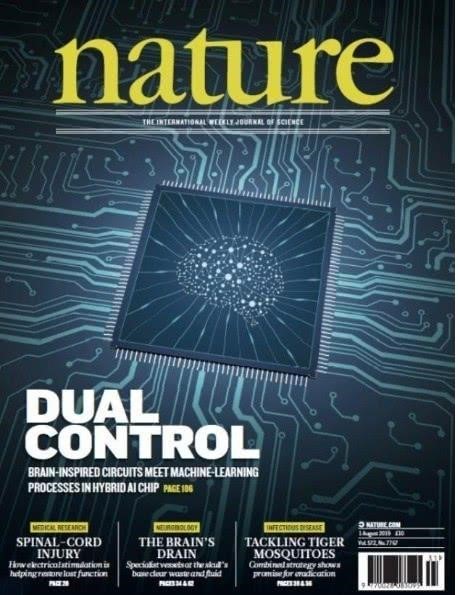What is the brain-inspired chip?
Recently, the team, guided by Professor Shi Luping at the Center for Brain Inspired Computing Research of Tsinghua University, has developed the world's first heterogeneous fusion brain-inspired computing chip, called Tianjic. It has appeared on the cover of Nature and made the brain-inspired chip become a hot issue. What is brain-inspired chip? How advanced is its technology? The author sorts out data on the net and gives a brief introduction.
In a nutshell, brain-inspired chip is one of the architecture of AI chip. It is designed based on the way similar human brain works. Compare with the traditional chip, brain-inspired chip has more advantages in power consumption and learning ability. Tradition computer chip is designed in accordance with the architecture of John von Neumann. The storage and computing are separated in space. So the computer needs to make repeated calls in CPU and memory each time the computer performs an operation. The frequent data transfer results in low efficiency of processing mass information. Besides, when the chip is operating, a majority of electric power will turn into heat power, causing increased consumption.

Compare with the brain-inspired chip, as the advanced AI product with hundreds of millions of years of evolution in nature, when human brain operates intelligent computing tasks, the performance of Human brain has far more than the computer architecture today. In conclusion, the human brain includes the following characteristics: at first, human brain is the integration of storage and computation in which both storing information and processing information work at the same time. Secondly, human brain has large scale. The human brain is made up of tens of billions of neurons which develop into a large-scale organic system via very complex interconnection. So many people consider that if you want to stimulate the real human brain, you must reach a certain scale to see the performance of human brain-like, which is also the reason why True North pursues the large-scale interconnection. Thirdly, human brain has some obvious function divisions, such as visual zone, auditory zone, emotional zone and so on. These different function divisions work together to finish the activity of brain. Fourthly, the human brain possesses high parallelism when it operates tasks. Fifthly, human brain has very low consumption, which is the trend of brain-inspiredchip development.
At present, the research of brain-inspiredchip is based on the combination of microelectronics and novel neuromorphic devices, which aims to break through the traditional computation architecture, achieve the deep integration of storage and computation, significantly increase the computing performance, raise integrated level and lower consumption.
Although the prospects of brain-inspiredchips are board, the brain-inspiredchip lies in the research and concept stage. In 2011, IBM had made progress in the brain-inspiredchip in advance. On the basis of stimulating the human brain structure, they developed two silicon chip prototype with perception and cognitive functions. Owing to the technology limited, the performance of first generation is not well. In 2014, the second generation True North came into being, using Samsung 28nm process and 5.4 billion transistors, whose performance is better than the first generation. The power consumption is only 20 milliwatts per square centimeter which is one percent of the first generation with only a few centimeters in diameter that is one-fifth of the first generation. True North chip with neural network model can be regarded as real-time perceptual flow inference engine to classify fast and accurately and keep very low power consumption.
In addition to True North, there are Intel Loihi chip, Qualcomm Zeroth chip, Westwell DeepSouth chip, Zhejiang University "Darwin" brain-inspiredchip and AL-CTX chip working on the brain-inspiredchip. But, these products have still long way to reach large-scale commercialization.
Tianjic chip, developed by Tsinghua University, is the world’s first heterogeneous fusion brain-inspiredcomputing chip which has combined two technological ways, improved functions of all system and hoped to make further steps to promote the research and development of artificial general intelligence.
Recently, Chinese scientists have successfully developed a new brain-inspiredcomputing chip for artificial general intelligence --”Tianjic chip” and succeeded in carrying out experiments on unmanned bicycles, causing great concern in the US scientific community.

On the August st, the international authoritative journal Nature published a paper on the team of Professor Shi Luping from the Brain Computing Research Center of Tsinghua University in the form of a cover article. Tianjic chip is a new type of AI chip which has integrated the two main research trends of AI based on computer science and neuroscience-based methods into a platform which also supports machine learning algorithm and existing brain-inspiredcalculation algorithm.
The researchers verified the chip's capabilities on a unmanned bicycle. The bicycle with "Tianjic chip" realizes real-time visual target detection, target tracking, automatic obstacle avoidance and obstacle avoidance, adaptive attitude control, voice understanding control and self-determination.
the Massachusetts institute of technology's technology review said that the successful experiment on a unmanned bicycle with Tianjic chip shows China's growing expertise in chips and the value of new chip design methods aimed at optimizing AI algorithms. The article said that Chinese researchers demonstrated their ability to develop specialized AI chips, reflecting significant progress in improving China's chip design capabilities.
According to an article in the New York times, equipped with an AI chip, it could be "the closest thing to autonomous thinking on a unmanned bicycle”. The article said that the project uses new chips to achieve higher levels of AI and hopes that such chips will help automate machines at levels not currently possible.
Eric Topol, an expert at the well-know Scripps Research Institute in the United States, said that the development of the "Tianjic chip" and its experiments on unmanned bicycles have successfully demonstrated this combination of machine learning and brain-inspired brains. The hybrid design of the algorithm marks an important moment in the development of AI.
